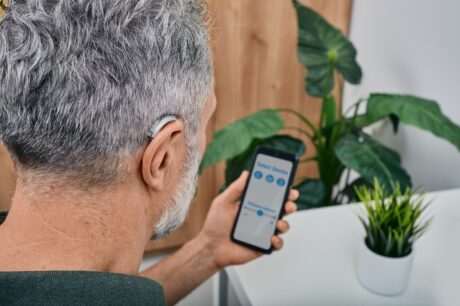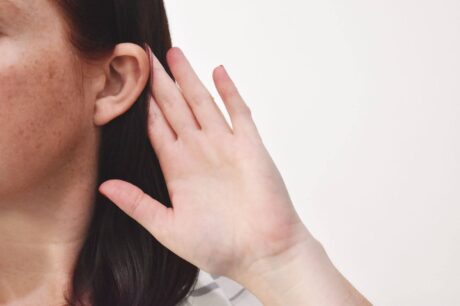Did you know that earwax buildup may contribute to temporary hearing loss and may affect your hearing aid’s performance? When earwax accumulates, it can block your ear canal, potentially causing a reduction in hearing. Many people who experience uncomfortable feelings with their ears tend to search for how to clean earwax from home and often purchase cotton buds (q-tips) for ear cleaning, but we are going to stop you here.
Ear cleaning is not as simple as it sounds. Not everything that you find online falls true when it comes to taking good care of your precious ear. In this article, we will clarify all the common knowledge about ear cleaning and shed light on the misconceptions from an expert’s standpoint.
Please note the content in this article is for educational purposes and shall not be viewed as a medical device. If you experience significant earwax buildup with hearing issues, consult a healthcare provider or audiologist. They can provide appropriate guidance for earwax extraction or hearing aid solutions.
Common Myths About Ear Cleaning
Myth 1: Earwax is Dirty and Should Be Removed Frequently
Fact: Earwax, also known as cerumen, might seem like something “dirty” and need to be removed frequently, but it’s actually there for a good reason. First of all, earwax is used to lubricate the skin inside our ears so that they won’t get too dry. It also protects our ears by trapping dust, dirt, and other foreign substances, helping to keep the ear canal clean naturally.
Myth 2: You Should Clean Your Ears Every Day
Fact: You might be surprised to find out that our ears can, in fact, clean themselves. The earwax that our ears produce is actually created to help clean our ear canals from foreign substances such as dust and hair pieces. It works by taking these substances with it as it flakes off our ear when it nears the opening. This natural process reduces the need for daily cleaning.
Myth 3: Ear Candles are Effective for Removing Earwax
Fact: Ear candling is an alternative medicine practice that claims to clean ears and promote overall health. The process begins by dripping candle wax into the ear. The wax then hardens and the earwax attaches to the hardened candle wax. It ends by pulling out the candle wax, with all the earwax attached to it. It risks damaging the ear canal, going as far as the eardrums. These may cause serious damage to one’s ear such as infections.
Myth 4: If Your Ears Itch, It’s a Sign You Need to Clean Them
Fact: Itchy ears do not necessarily indicate a need for cleaning. Itchiness can be caused by dryness, allergies, or other conditions. Overcleaning can exacerbate the problem, as it removes the protective earwax. You can talk to an ENT specialist to determine the cause of persistent itching rather than resorting to frequent self-cleaning with a cleaning pick or cotton buds.
Myth 5: Using Cotton Buds for Ears is the Best Way to Clean Them
Fact: This is probably the biggest myth on the list. While cotton buds (some call it Q-tips) are good tools for many things, it is not the best ones for ear cleaning. This is simply because of the damage it can cause to the insides of the ear. Moreover, it can also push the wax further in instead of “pulling” them out.
If you want to have good ear hygiene, you’ll have to know what not to clean your ears with. Read on to find out how you can clean your ears properly.
Important Facts About Ear Cleaning
Fact 1: The Ear Canal is Self-Cleaning
The ear canal has a natural mechanism for self-cleaning. The movement of the jaw assists in transporting earwax and debris from the inner ear to the outer ear, where it can be wiped away. This reduces the need for manual ear wax cleaning, minimising the risk of damage.
Fact 2: Earwax is a Natural and Protective Substance
Earwax is a natural substance with a blend of oily secretions, waxy secretions, and dead skin cells. This mix of substances actually protects the ear canal. It cleans the ear by trapping dust, dirt, and other particles, preventing them from reaching the eardrum. Additionally, earwax has antibacterial properties that help protect the ear from infections.
Fact 3: Professional Ear Cleaning is Sometimes Necessary
While the ear canal is self-cleaning, there are times when professional ear cleaning may be needed. Excessive earwax buildup, which can cause discomfort, temporary hearing loss or infections, may require professional removal methods.
Some people would opt for ear syringing (ear irrigation), but this is not suitable for everyone, as ear syringing may worsen existing eardrum perforations or damage inner ear structures due to forceful water pressure. Consider micro-suction ear wax removal, where a tiny vacuum is used to remove earwax under a microscope.
Fact 4: Over-the-Counter Ear Drops Can Help Soften Earwax
Over-the-counter ear drops can be effective in softening hardened earwax. These drops are usually oil- or water-based and work differently:
- Oil-Based Ear Drops: These drops contain mineral oil, olive oil, or other oils. The oil works by gently penetrating and softening hardened earwax, allowing it to break down and move outward more easily. This mimics the natural lubricating properties of sebum produced by the ear canal glands.
- Water-Based Ear Drops: These drops contain ingredients like hydrogen peroxide or carbamide peroxide. These solutions work differently. Instead of lubrication, they target the structure of the earwax itself. They dissolve or loosen the bonds within the earwax, making it easier for the natural cleaning process.
Please note that these ear drops should be used according to the instructions provided carefully. Using them excessively or incorrectly could irritate the ear canal or even lead to temporary hearing loss.
Fact 5: Good Ear Hygiene Involves Keeping the Outer Ear Clean and Dry
Maintaining good ear hygiene involves regularly cleaning your outer ear, which is the visible portion you can see and touch. Moisture buildup in the ear canal can create a breeding ground for bacteria and contribute to infections. After showering or swimming, you can gently dry the outer ear to prevent excess moisture. This helps maintain a healthy balance in the ear canal environment.
How to Clean Your Ears Safely
Safe Ways to Clean Ears:
- Use a Damp Cloth: Gently wipe the outer ear with a damp cloth to remove earwax and debris.
- Ear Drops: Use over-the-counter ear drops to soften earwax for natural removal.
- Professional Ear Cleaning: Seek professional help for safer ear wax extraction.
How Not to Clean Your Ears:
- Don’t Use Any Objects for Ear Digging: Avoid using cotton buds, ear cleaning picks and harsh objects for ear digging. Inserting cotton buds into ears can push earwax deeper into the ear canal, leading to blockages.
- Do Not Use Ear Candles: As we mentioned above, ear candling will do more harm than good, and may cause burns or injuries.
Conclusion
Earwax may seem like an unwanted visitor, but it actually contributes to your ear health. By understanding how ears clean themselves and practising gentle outer ear hygiene, you can enjoy better ear health. If you experience any issues with your ears such as hearing loss or itching, consult a healthcare provider or audiologist for personalised ear care advice.
About the Listening Lab
Listening Lab is a home-grown company whose mission is to help our clients restore their hearing to enjoy the life that they desire. Experiencing hearing loss can be detrimental to one’s quality of life. Hence we commit to providing high-quality hearing solutions.
Our hearing solutions include hearing tests and treatment and prescribing hearing aids. Clients may come to get their hearing checked, and we will assess whether hearing aids are required.
If hearing aids are required, clients can choose from a variety of the best hearing aid brands we provide. Each of the products offers unique features that complement daily use and perform well in helping our clients enjoy the life that they desire.


















